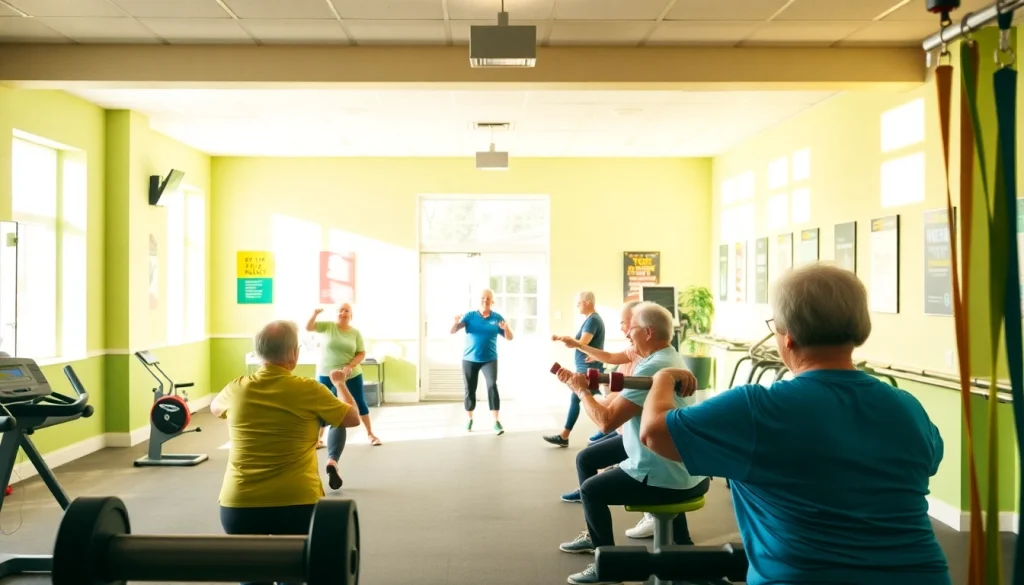Understanding Senior Fitness Training
As our population ages, the importance of Senior Fitness Training has become increasingly evident. This specific domain of fitness not only addresses physical health but also promotes mental well-being, social interaction, and overall quality of life for older adults. Engaging in tailored fitness programs can help seniors maintain independence, improve their mobility, and mitigate health risks associated with aging.
The Importance of Fitness in Aging
Fitness is crucial for seniors due to the natural decline in muscle mass, bone density, and overall mobility that accompanies aging. Regular physical activity can counteract many age-related ailments, including heart disease, diabetes, and osteoporosis. Furthermore, exercise fosters better mental health, helping reduce symptoms of depression and anxiety while enhancing cognitive function. Recognizing the importance of a proactive approach to fitness can significantly impact the lives of seniors.
Core Principles of Senior Exercise Programs
Senior exercise programs are constructed around several core principles designed to meet the unique needs of older adults:
- Individualization: Each program should be tailored to the individual’s physical capabilities, health conditions, and personal goals.
- Progression: Exercises should begin at a lower intensity and progressively increase in difficulty as strength and endurance improve.
- Variety: Incorporating a mix of cardiovascular, strength, flexibility, and balance training keeps the program engaging and holistic.
- Safety: Ensuring a safe exercise environment and promoting safe practices are paramount to preventing injuries.
Common Misconceptions About Senior Fitness
Despite the benefits of fitness for seniors, several misconceptions persist:
- Myth 1: Older adults should avoid exercise to prevent injury. Fact: Regular, appropriate exercise can actually reduce the risk of falls and injuries.
- Myth 2: Seniors cannot build strength or endurance. Fact: Older adults can gain strength and maintain fitness levels through tailored training.
- Myth 3: Fitness programs for seniors must be low-intensity. Fact: Seniors can safely engage in moderate to high-intensity training, depending on their fitness status.
Key Components of Effective Senior Fitness Training
Strength Training for Older Adults
Strength training is vital for preserving muscle mass and bone density. As people age, they naturally lose muscle—this process, known as sarcopenia, can begin as early as the mid-30s. Incorporating strength training not only counters this loss but also improves functional performance, enhances metabolism, and boosts overall health.
Recommended strength exercises for seniors include:
- Resistance band exercises
- Bodyweight exercises, such as squats and lunges
- Light weights, including dumbbells and kettlebells
Flexibility and Balance Exercises
Flexibility and balance training are crucial for maintaining functional independence. Regular stretching helps improve range of motion, while balance exercises are essential for fall prevention. Key exercises can include:
- Yoga or Tai Chi to promote flexibility and balance
- Heel-to-toe walking to enhance stability
- Seated stretches to maintain flexibility
Cardiovascular Activities for Seniors
Cardiovascular health is crucial for seniors, as heart disease remains a leading cause of mortality in this demographic. Regular aerobic activity strengthens the heart, improves lung capacity, and enhances overall endurance. Recommended activities encompass:
- Brisk walking
- Swimming or water aerobics
- Cycling, either on a stationary bike or outdoors
Safety Considerations in Senior Fitness Training
Assessing Physical Limitations and Health Risks
Before beginning any exercise program, seniors should undergo a comprehensive health evaluation. This assessment should include an overview of current physical capabilities, existing health conditions, and potential exercise-related restrictions. Working with a healthcare provider or a certified senior fitness instructor is advisable to develop a personalized plan that considers these factors.
Choosing Appropriate Exercise Equipment
Safety starts with the right equipment. Not all exercise gear is suitable for seniors. Opting for lighter weights, resistance bands, or stability balls can provide safe alternatives. Additionally, using supportive footwear and ensuring a clear, clutter-free exercise area significantly reduces injury risks.
Supervision and Support in Workouts
Having a trained professional guide workouts can enhance safety and efficacy. A certified trainer experienced in senior fitness can provide supervision and support, ensuring exercises are performed correctly and modifications are made as needed.
Finding the Right Senior Fitness Programs
Locating Certified Senior Fitness Instructors
When seeking a fitness instructor, look for individuals who hold specific senior fitness certifications. Organizations such as the American Council on Exercise (ACE) and the National Academy of Sports Medicine (NASM) offer specialized courses that prepare trainers to work with older adults effectively.
Online Resources and Classes for Seniors
The rise of digital fitness resources offers innovative options for seniors who prefer exercising at home. Numerous platforms provide tailored workouts, instructional videos, and community support. Websites and apps such as Senior Fitness with Meredith feature low-impact exercises designed specifically for older adults, making fitness accessible to a wider audience.
Building a Supportive Community for Active Seniors
Joining fitness classes or community groups allows seniors to engage socially while exercising, enhancing motivation and accountability. These connections foster a sense of belonging and support, crucial for maintaining an active lifestyle.
Measuring Success in Senior Fitness Training
Setting Realistic Goals and Milestones
Establishing clear, attainable goals is essential for maintaining motivation. Goals may range from improving balance, increasing walking endurance, or enhancing flexibility. Setting short-term milestones can create a roadmap to success, allowing seniors to celebrate their progress.
Tracking Progress and Health Improvements
Regularly documenting progress—be it through journaling workouts or using fitness tracking apps—can help seniors visualize their improvements over time. Monitoring vital statistics like resting heart rate, weight, and flexibility can also provide essential insights into their health status.
Long-term Benefits of Regular Fitness Activities
The benefits of engaging in regular fitness activities extend much further than immediate physical health improvements. Long-term engagement in fitness can lead to enhanced mental clarity, reduced risk of chronic diseases, and an improved quality of life, enabling seniors to maintain independence and social connections well into their golden years.


